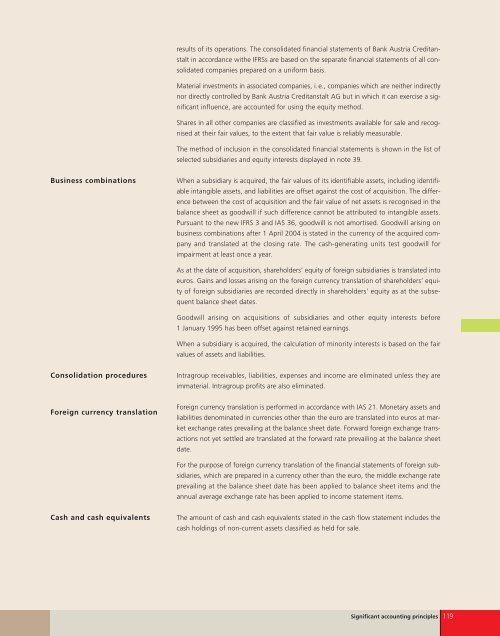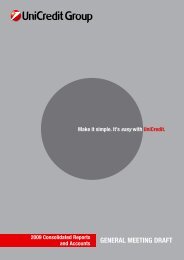team spirit - Bankier.pl
team spirit - Bankier.pl
team spirit - Bankier.pl
Create successful ePaper yourself
Turn your PDF publications into a flip-book with our unique Google optimized e-Paper software.
Business combinations<br />
Consolidation procedures<br />
Foreign currency translation<br />
Cash and cash equivalents<br />
results of its operations. The consolidated financial statements of Bank Austria Creditanstalt<br />
in accordance withe IFRSs are based on the separate financial statements of all consolidated<br />
companies prepared on a uniform basis.<br />
Material investments in associated companies, i.e., companies which are neither indirectly<br />
nor directly controlled by Bank Austria Creditanstalt AG but in which it can exercise a significant<br />
influence, are accounted for using the equity method.<br />
Shares in all other companies are classified as investments available for sale and recognised<br />
at their fair values, to the extent that fair value is reliably measurable.<br />
The method of inclusion in the consolidated financial statements is shown in the list of<br />
selected subsidiaries and equity interests dis<strong>pl</strong>ayed in note 39.<br />
When a subsidiary is acquired, the fair values of its identifiable assets, including identifiable<br />
intangible assets, and liabilities are offset against the cost of acquisition. The difference<br />
between the cost of acquisition and the fair value of net assets is recognised in the<br />
balance sheet as goodwill if such difference cannot be attributed to intangible assets.<br />
Pursuant to the new IFRS 3 and IAS 36, goodwill is not amortised. Goodwill arising on<br />
business combinations after 1 April 2004 is stated in the currency of the acquired company<br />
and translated at the closing rate. The cash-generating units test goodwill for<br />
impairment at least once a year.<br />
As at the date of acquisition, shareholders’ equity of foreign subsidiaries is translated into<br />
euros. Gains and losses arising on the foreign currency translation of shareholders’ equity<br />
of foreign subsidiaries are recorded directly in shareholders’ equity as at the subsequent<br />
balance sheet dates.<br />
Goodwill arising on acquisitions of subsidiaries and other equity interests before<br />
1 January 1995 has been offset against retained earnings.<br />
When a subsidiary is acquired, the calculation of minority interests is based on the fair<br />
values of assets and liabilities.<br />
Intragroup receivables, liabilities, expenses and income are eliminated unless they are<br />
immaterial. Intragroup profits are also eliminated.<br />
Foreign currency translation is performed in accordance with IAS 21. Monetary assets and<br />
liabilities denominated in currencies other than the euro are translated into euros at market<br />
exchange rates prevailing at the balance sheet date. Forward foreign exchange transactions<br />
not yet settled are translated at the forward rate prevailing at the balance sheet<br />
date.<br />
For the purpose of foreign currency translation of the financial statements of foreign subsidiaries,<br />
which are prepared in a currency other than the euro, the middle exchange rate<br />
prevailing at the balance sheet date has been ap<strong>pl</strong>ied to balance sheet items and the<br />
annual average exchange rate has been ap<strong>pl</strong>ied to income statement items.<br />
The amount of cash and cash equivalents stated in the cash flow statement includes the<br />
cash holdings of non-current assets classified as held for sale.<br />
Significant accounting princi<strong>pl</strong>es 119
















